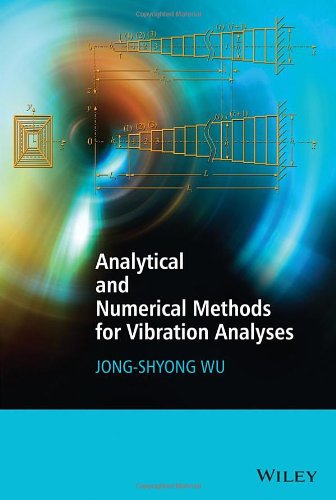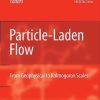Analytical and numerical methods for vibration analyses 1st Edition by JongShyong Wu9781118632406 1118632400
$50.00 Original price was: $50.00.$35.00Current price is: $35.00.
Analytical and numerical methods for vibration analyses 1st Edition by JongShyong – Ebook PDF Instant Download/Delivery:
9781118632406, 1118632400
Full download Analytical and numerical methods for vibration analyses 1st Edition after payment

Product details:
ISBN 10: 1118632400
ISBN 13: 9781118632406
Author: JongShyong Wu
This book illustrates theories and associated mathematical expressions with numerical examples using various methods, leading to exact solutions, more accurate results, and more computationally efficient techniques. It presents the derivations of the equations of motion for all structure foundations using either the continuous model or the discrete model. It discusses applications for students taking courses including vibration mechanics, dynamics of structures, and finite element analyses of structures, the transfer matrix method, and Jacobi method.
Analytical and numerical methods for vibration analyses 1st Table of contents:
1 Introduction to Structural Vibrations
- 1.1 Terminology
- Table 1.1 The main differences between a discrete system and a continuous system
- 1.2 Types of Vibration
- Figure 1.1 (a) A two-node 3D beam element and its 12 nodal displacements, ui (i = 1 to 12). (b) A 3D free–free beam with total length L and composed of n uniform beam elements and n + 1 nodes.
- Table 1.2 The lowest several natural frequencies and mode shapes of the 3D free–free uniform beam shown in Figure 1.1(b)
- Figure 1.2 The 6-DOF rigid-body motions of a ship in the xyz coordinate system: surge (ux), sway (uy), heave (uz), roll (θx), pitch (θy) and yaw (θz).
- 1.3 Objectives of Vibration Analyses
- 1.3.1 Free Vibration Analysis
- Figure 1.3 The natural frequency chart illustrating the ranges of natural frequencies for vertical and horizontal vibrations of a ship in light and heavy loading conditions.
- 1.3.2 Forced Vibration Analysis
- Table 1.3 The lowest five natural frequencies and mode shapes of the 2D pinned–pinned uniform beam shown in Figure 1.4
- Figure 1.4 A pinned-pinned uniform beam subjected to a harmonic exciting force F(t) = F0 sin ωe t applied at point A with x¯A=L/4=0.5m.
- Figure 1.5 Time histories of vertical displacements of the three equally spaced points A, B and C on the P-P beam shown in Figure 1.4 due to excitation of F(t) = 1.0 sin ωe t (newtons) at point A with: (a) ωe = 100 rad/s; (b) ωe = 130 rad/s; and (c) ωe = 150 rad/s.
- Figure 1.6 The frequency-response amplitude curves for vertical displacements of the three points A, B and C on the 2D P-P beam subjected to a harmonic exciting force F (t) = 1.0 sin ωe t (newtons) applied at point A (cf. Figure 1.4) obtained from the time-history method.
- 1.3.1 Free Vibration Analysis
- 1.4 Global and Local Vibrations
- Figure 1.7 (a) The entire ship hull and its (b) two-node vertical, (c) three-node vertical, (d) four-node vertical and (e) one-node torsional vibration mode shapes.
- Figure 1.8 Mathematical model of the propulsive shafting system of a 42 100 bhp container for the 3D finite element analysis. From Wu and Hsieh [14].
- 1.5 Theoretical Approaches to Structural Vibrations
- References
2 Analytical Solutions for Uniform Continuous Systems
- 2.1 Methods for Obtaining Equations of Motion of a Vibrating System
- 2.2 Vibration of a Stretched String
- 2.2.1 Equation of Motion
- Figure 2.1 (a) A transversely vibrating string subjected to tension T(x) and external load p(x, t). (b) The free-body diagram of the string element dx.
- 2.2.2 Free Vibration of a Uniform Clamped-Clamped String
- Figure 2.2 The sixth to tenth natural (or unit-amplitude) mode shapes of the stretched clamped-clamped uniform string.
- 2.2.1 Equation of Motion
- 2.3 Longitudinal Vibration of a Continuous Rod
- 2.3.1 Equation of Motion
- Figure 2.3 (a) A non-uniform rod subjected to the external load N(x, t). (b) The free-body diagram for the rod element dx.
- 2.3.2 Free Vibration of a Uniform Rod
- Table 2.1 The lowest several non-dimensional frequency coefficients βrL and natural frequencies ωr (rad/s) for a longitudinally vibrating uniform rod in F-F, C-C and C-F BCs
- Figure 2.4 The lowest several natural (or unit-amplitude) mode shapes of the longitudinally vibrating uniform rod with corresponding natural frequencies shown in Table 2.1 in the boundary conditions: (a) F-F, (b) C-C and (c) C-F.
- Problem 2.1
- 2.3.1 Equation of Motion
- 2.4 Torsional Vibration of a Continuous Shaft
- 2.4.1 Equation of Motion
- Figure 2.5 (a) A non-uniform circular shaft subjected to the external torque mt(x, t) per unit length. (b) The free-body diagram of the shaft segment dx.
- Example 2.1
- 2.4.2 Free Vibration of a Uniform Shaft
- Example 2.2
- Figure 2.6 A uniform C-F shaft carrying a rigid disk at the free end.
- Figure 2.7 (a) For the C-F shaft shown in Figure 2.6 carrying a rigid disk at the tip (with polar mass moment of inertia JD = pIpL), the values of βL corresponding to the intersections of the dotted and solid lines determine the lowest five non-dimensional frequency coefficients βrL: 0.8603, 3.4256, 6.4373, 9.5293 and 12.6453. (b) The lowest five unit-amplitude mode shapes of the same C-F shaft.
- Problem 2.2
- Problem 2.3
- 2.4.1 Equation of Motion
- 2.5 Flexural Vibration of a Continuous Euler-Bernoulli Beam
- 2.5.1 Equation of Motion
- Figure 2.8 A transversely vibrating Euler-Bernoulli beam: (a) the external force p(x, t) and external moment mb(x, t) in the coordinate system oxyz; (b) the free-body diagram for the differential beam segment dx.
- 2.5.2 Free Vibration of a Uniform Euler-Bernoulli Beam
- Figure 2.9 The values of βL corresponding to the intersections of the solid line with the dotted line and with the dashed line determine the lowest several frequency coefficients βL of the F-F beam and C-F beam, respectively.
- Figure 2.10 The intersections of the dotted line and the solid lines determine the values of the non-dimensional frequency coefficients βL for the roots of the frequency equation of the C-P beam, tan βL = tanh βL.
- 2.5.3 Numerical Example
- Table 2.2(a) The lowest five frequency coefficients of the uniform Euler-Bernoulli beam with L = 2.0m, d = 0.05m, E = 2.068 × 1011 N/m2 and ρ = 7850 kg/m3
- Table 2.2(b) The lowest five normalization factors A˜r obtained from Simpson’s rule (with n = 100) for the uniform Euler-Bernoulli beam in five BCs with frequency coefficients βrL shown in Table 2.2(a)
- Table 2.2(c) The amplitudes |Yr(x)|max of lowest five natural mode shapes (with constant Ar = 1 in Equations (2.132), (2.159), (2.170), (2.181) and (2.191) and normal mode shapes for the uniform Euler-Bernoulli beam in five BCs with frequency coefficients βrL shown in Table 2.2(a)
- Figure 2.12 The lowest five unit-amplitude mode shapes for transverse vibration of the uniform Euler-Bernoulli beam with frequency coefficients βrL shown in Table 2.2(a) in the boundary conditions: (a) F-F, (b) C-C, (c) P-P, (d) C-F and (e) C-P.
- Figure 2.11 The lowest five natural mode shapes for transverse vibration of the uniform Euler-Bernoulli beam with frequency coefficients βrL shown in Table 2.2(a) in the boundary conditions: (a) F-F, (b) C-C, (c) P-P, (d) C-F and (e) C-P.
- Figure 2.13 The lowest five normal mode shapes Y˜r(x) for transverse vibration of the uniform Euler-Bernoulli beam with frequency coefficients βrL shown in Table 2.2(a) in the boundary conditions: (a) F-F, (b) C-C, (c) P-P, (d) C-F and (e) C-P.
- 2.5.1 Equation of Motion
- 2.6 Vibration of Axial-Loaded Uniform Euler-Bernoulli Beam
- 2.6.1 Equation of Motion
- Figure 2.14 An axial-loaded Euler-Bernoulli beam performing transverse vibration: (a) the external loads, p(x, t), mb(x, t) and N, in the coordinate system oxyz; (b) the free-body diagram of the differential beam segment dx.
- 2.6.2 Free Vibration of an Axial-Loaded Uniform Beam
- 2.6.3 Numerical Example
- Table 2.3 Influence of axial load N on the lowest five frequency coefficients βrLωr2ρA/(EIz)4L= (or natural frequencies ωr, rad/s) of an Euler-Bernoulli beam in the BCs: (a) F-F, (b) C-C, (c) P-P, (d) C-F and (e) C-P
- Figure 2.15 Influence of axial load N on the lowest five natural frequencies of the uniform Euler-Bernoulli beam, ωr (rad/s) (r = 1 − 5),
- 2.6.1 Equation of Motion
People also search for Analytical and numerical methods for vibration analyses 1st :
difference between analytical and numerical methods
difference between analytical and numerical methods with examples
journal of analytical and numerical methods in mining engineering
international journal of analytical and numerical methods in geomechanics
partial differential equations analytical and numerical methods
Tags:
JongShyong Wu,Analytical,numerical methods



